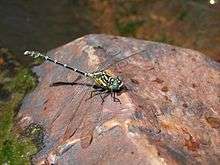Hemigomphus gouldii
Hemigomphus gouldii is a species of dragonfly of the family Gomphidae,[3] known as the southern vicetail.[4] It is a small, black and yellow dragonfly, endemic to eastern Australia, where it inhabits permanent streams and rivers.[5][6]
| Southern vicetail | |
|---|---|
 | |
| Male Hemigomphus gouldii | |
| Scientific classification | |
| Kingdom: | Animalia |
| Phylum: | Arthropoda |
| Class: | Insecta |
| Order: | Odonata |
| Infraorder: | Anisoptera |
| Family: | Gomphidae |
| Genus: | Hemigomphus |
| Species: | H. gouldii |
| Binomial name | |
| Hemigomphus gouldii | |
 | |
Gallery
.jpg) Male
Male.jpg) Male showing vice tail
Male showing vice tail.jpg) Male side view
Male side view.jpg) Clinging on to a blade of grass
Clinging on to a blade of grass.jpg) Male showing wing venation
Male showing wing venation.jpg) Male from above
Male from above.jpg) Male from in front
Male from in front.jpg) Face on
Face on.jpg) Face down
Face down.jpg) Female wings
Female wings.jpg) Male wings
Male wings
gollark: acidified.
gollark: https://rust-unofficial.github.io/too-many-lists/
gollark: I am!
gollark: I have to admit postfix await was a cool idea.
gollark: Wouldn't it be `p.free().await?.free().await?` then?
See also
References
| Wikimedia Commons has media related to Hemigomphus gouldii. |
- Dow, R.A. (2017). "Hemigomphus gouldii". IUCN Red List of Threatened Species. 2017: e.T14278139A59256733. doi:10.2305/IUCN.UK.2017-1.RLTS.T14278139A59256733.en.
- Selys-Longchamps, Edmond (1854). "Synopsis des Gomphines". Bulletin de la Classe des Science, Académie Royale de Belgique (in French). 21 (7): 23–112 [64] – via Biodiversity Heritage Library.
- "Species Hemigomphus gouldii (Selys, 1854)". Australian Faunal Directory. Australian Biological Resources Study. 2012. Retrieved 20 February 2017.
- Theischinger, Günther; Hawking, John (2006). The Complete Field Guide to Dragonflies of Australia. Collingwood, Victoria, Australia: CSIRO Publishing. p. 188. ISBN 978 0 64309 073 6.
- Theischinger, Gunther; Endersby, Ian (2009). Identification Guide to the Australian Odonata. Department of Environment, Climate Change and Water NSW. p. 219. ISBN 978 1 74232 475 3.
- Watson, J.A.L.; Theischinger, G.; Abbey, H.M. (1991). The Australian Dragonflies: A Guide to the Identification, Distributions and Habitats of Australian Odonata. Melbourne: CSIRO. p. 278. ISBN 0643051368.
This article is issued from Wikipedia. The text is licensed under Creative Commons - Attribution - Sharealike. Additional terms may apply for the media files.
